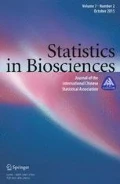Abstract
The standard methods of diagnosing disease based on antibody microtiter plates are quite crude. Few methods create a rigorous underlying model for the antibody levels of populations consisting of a mixture of positive and negative subjects, and fewer make full use of the entirety of the available data for diagnoses. In this paper, we propose a Bayesian hierarchical model that provides a systematic way of pooling data across different plates, and accounts for the subtle sources of variations that occur in the optical densities of typical microtiter data. In addition to our Bayesian method having good frequentist properties, we find that our method outperforms one of the standard crude approaches (the “3 SD Rule”) under reasonable assumptions, and provides more accurate disease diagnoses in terms of both sensitivity and specificity.








Similar content being viewed by others
References
Casella G, George E (1992) Explaining the Gibbs sampler. Am Stat 46:167–174
Choi Y, Johnson W, Collins M, Gardner I (2006) Bayesian inferences for receiver operating characteristic curves in the absence of a gold standard. J Agric Biol Environ Stat 11:210–229. doi:10.1198/108571106X110883
Gelfand AE, Smith AFM (1990) Sampling-based approaches to calculating marginal densities. J Am Stat Assoc 85(410):398–409
Gelman A, Chew GL, Shnaidman M (2004) Bayesian analysis of serial dilution assays. Biometrics 60:407–417
Gelman A (2006) Prior distributions for variance parameters in hierarchical models. Bayesian Anal 1:1–19
Greiner M, Pfeiffer D, Smith RD (2000) Principles and practical application of the receiver-operating characteristic analysis for diagnostic tests. Prev Vet Med 45:23–41
Hastings WK (1970) Monte Carlo sampling methods using Markov chains and their applications. Biometrika 57:97–109
Higgins KM, Davidian M, Chew G, Burge H (1998) The effect of serial dilution error on calibration inference in immunoassay. Biometrics 54:19–32
Hobert JP, Roy V, Robert C (2011) Improving the convergence properties of the data augmentation method with an application to Bayesian mixture modeling. Stat Sci 26(3):332–351
Irion A, Beck HP, Smith T (2002) Assessment of positivity in immuno-assays with variability in background measurements: a new approach applied to the antibody response to Plasmodium falciparum MSP2. J Immunol Methods 259:111–118
Kurkjian KM, Vaz LE, Haque R, Cetre-Sossah C, Akhter S, Roy S, Steurer F, Amann J, Ali M, Chowdhury R, Wagatsuma Y, Williamson J, Crawford S, Breiman RF, Maguire JH, Bern C, Secor WE (2005) Application of an improved method for the recombinant k 39 enzyme-linked immunosorbent assay to detect visceral leishmaniasis disease and infection in Bangladesh. Clin Diagn Lab Immunol 12:1410–1415
Levy MZ, Bowman NM, Kawai V, Plotkin JB, Waller LA, Cabrera L, Steurer F, Seitz AE, Pinedo-Cancino VV, Cornejo del Carpio JG, Cordova Benzaquen E, McKenzie FE, Maguire JH, Gilman RH, Bern C (2009) Spatial patterns in discordant diagnostic test results for Chagas disease: links to transmission hotspots. Clin Infect Dis 48(8):1104–1106
Limmathurotsakul D, Chantratita N, Teerawattanasook N, Piriyagitpaiboon K, Thanwisai A, Wuthiekanun V, Day NP, Cooper B, Peacock SJ (2011) Enzyme-linked immunosorbent assay for the diagnosis of melioidosis: better than we thought. Clin Infect Dis 52:1024–1028
Lindsay BG, Roeder K (1993) Uniqueness of estimation and identifiability in mixture models. Can J Stat 21:139–147
Morris C (1983) Parametric empirical Bayes inference: theory and applications. J Am Stat Assoc 78(381):47–63
Moulton LH, Curriero FC, Barroso PF (2002) Mixture models for quantitative HIV RNA data. Stat Methods Med Res 11:317–325
Nielsen SS, Gronbaek C, Agger JF, Houe H (2002) Maximum-likelihood estimation of sensitivity and specificity of ELISAs and faecal culture for diagnosis of paratuberculosis. Prev Vet Med 53:191–204
Opsteegh M, Teunis P, Mensink M, Zuchner L, Titilincu A, Langelaar M, van der Giessen J (2010) Evaluation of ELISA test characteristics and estimation of Toxoplasma gondii seroprevalence in Dutch sheep using mixture models. Prev Vet Med 96:232–240
Rubin DB (1984) Bayesianly justifiable and relevant frequency calculations for the applied statistician. Ann Stat 12(4):1151–1172. doi:10.1214/aos/1176346785
Verani JR, Seitz A, Gilman RH, LaFuente C, Galdos-Cardenas G, Kawai V, de LaFuente E, Ferrufino L, Bowman NM, Pinedo-Cancino V, Levy MZ, Steurer F, Todd CW, Kirchhoff LV, Cabrera L, Verastegui M, Bern C (2009) Geographic variation in the sensitivity of recombinant antigen-based rapid tests for chronic Trypanosoma cruzi infection. Am J Trop Med Hyg 80(3):410–415
Wang C, Turnbull B, Grhn Y, Nielsen S (2007) Nonparametric estimation of roc curves based on bayesian models when the true disease state is unknown. J Agric Biol Environ Stat 12:128–146. doi:10.1198/108571107X178095
Author information
Authors and Affiliations
Corresponding author
Electronic supplementary material
Below is the link to the electronic supplementary material.
Rights and permissions
About this article
Cite this article
A. Entine, O., Small, D.S., Jensen, S.T. et al. Disease Diagnosis from Immunoassays with Plate to Plate Variability: A Hierarchical Bayesian Approach. Stat Biosci 7, 206–224 (2015). https://doi.org/10.1007/s12561-014-9113-5
Received:
Revised:
Accepted:
Published:
Issue Date:
DOI: https://doi.org/10.1007/s12561-014-9113-5




